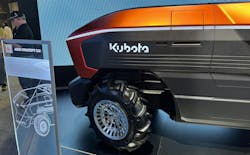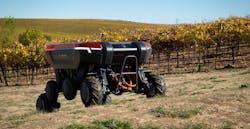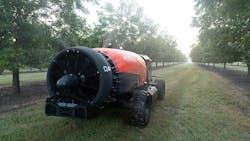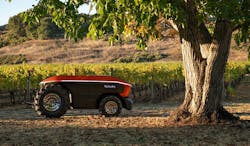Developing the technology behind Kubota's cutting-edge tractors
What you’ll learn:
- Kubota’s challenge is to conduct product development under a shared leadership structure that melds its tried-and-true R&D at the more rapid pace of tech company iteration cycles.
- Kubota in 2024 began working with the Silicon Valley Innovation Center in a strategy of buy some, contract with others.
- Commercializing the technology Kubota acquires through startups presents its own, unique headaches, for instance at the dealership level.
Manufacturers are wasting time, money, and putting tried-and-true processes at risk unless they understand the problems they’re trying to solve with technology—and can work with the more mercurial nature of tech companies to help solve their challenges.
If you don’t understand a pain point, you could solve a technology problem, but it’s the wrong problem. You could miss a chance to lock up IP and surrender long-term competitive advantage. And you could wind up with multiple companies, organizations, and departments that can’t coordinate with one another and figure out how to commercialize anything.
See also: Research shows tech growth in manufacturing off to a fast start in 2025
The challenge feels acute for Kubota, which is a mainstay in the heavy industrial sector. The Osaka, Japan-based company (but with U.S. subsidiaries) built its reputation on manufacturing tractors and construction equipment, vehicles built to withstand punishment and the test of time. Kubota’s R&D process takes between 18 months and two years to ensure adherence to its quality standards.
Tech startups don’t operate this way. Serial risk-takers with high tolerance for failure, they create success from nimble iteration. So how does a company like Kubota manage to blend predictable product design strategies with tech companies whose rapid iteration cycles feel unstable by comparison? In short, Kubota doesn’t.
What is your company doing about cybersecurity?
That’s what Todd Stucke, president of Kubota Tractor, finally realized. The solution lies in hooking these two very different ways of operating under a new, shared leadership structure specifically for technology development, giving one room to breathe without sacrificing the quality standards enforced by the other.
Pitching Tents in the Valley
In 2020, Kubota stepped into the world of autonomous vehicles by introducing in Japan the Agri Robo tractor series that farmers can drive manually to get the tractor onto the field and then switch to unmanned but monitored operation. Kubota in October 2020 announced a partnership with AI microchip giant NVIDIA to help develop fully autonomous vehicles.
The following year, it began investing in technology startups and acquired AgJunction, a company that develops autonomy technology for precision agriculture. Even though Kubota now owned AgJunction outright, Stucke knew better than to try absorbing the tech company into the larger Kubota organization.
See also: Rockwell surprises with 10% order growth
“If you bring them in, then you Kubota-ize them too fast, you lose what you bought. So, you have to be very careful that you keep them operating until you can harvest all their knowledge inside Kubota, and then you can bring them in,” Stucke said.
Commercialization support and getting AgJunction onto the same page with Kubota’s internal R&D and equipment engineering departments, on the other hand, required immediate action and a creative solution.
“Quite frankly, [startups] don’t know how to commercialize. … For the most part, what I found is they don’t have the skillset. Let them do the development, the R&D, the innovation, and then use Kubota to bring process, standards and quality into the products and the process procedure you need,” Stucke said.
Webinar: Cybersecurity center stage in 2025 and beyond
After a few years of trying to hit upon the right solution, Stucke in 2023 created what he refers to informally as his North American technology team.
Think of technology innovators like startups as one floor of a building, with internal Kubota R&D and equipment engineering on two other floors. The North American technology team provides the stairwells.
“We work together to make sure that we’re communicating very clearly with each group. This technology is going to go on this piece of equipment. Well, if you’re going put it on that piece of equipment, we have to have this wiring harness. Or, if we’re going to do drive-by-wire, we have to have a CAN [controller area network] bus that has a language [the technology] can talk to,” Stucke said.
Joshua Skanderup, Kubota Tractor's senior director of solutions commercialization, said the North American technology team is less an official department or structure and more a deliberate way of breaking down silos.
See also: Lessons for CIOs on how AI is changing the customization game
“Everybody is staying busy, everybody’s working on good things, but we [might not] know what everybody else is doing. So you end up with…projects that are the same, more or less, but slightly different enough that you can’t just combine them. Or maybe we’re chasing different priorities. And in any good R&D mix, you have a range [of ideas] that are very speculative,” Skanderup said.
“On the other side, you have teams that don’t have that luxury. They need to have practical things that work. Bringing together that whole spectrum of teams and kind of initiatives, at least pointing them in the same direction [to establish] we have the same priorities. We’re trying to solve the same kinds of problems,” Skanderup added.
Rent or Own Tech Companies?
Last year, Kubota bought another technology startup, Bloomfield, that develops a plant health vision system. Kubota also began working with the Silicon Valley Innovation Center—it’s a strategy of buy some, contract with others. Stucke said the question of buying or partnering generally comes down to the complexity of the problem Kubota is trying to solve for customers.
For example, some customers want an automated picking machine. Bloomfield develops vision system technology that scans fruit to determine size, ripeness and health among other things to determine which honeycrisp to pick.
That’s only one aspect of the technical challenge. There’s also compute speed. Sending image files to the cloud slows down the identification process (assuming that you can get good Internet access at an orchard in Wapato, Washington), versus edge processing, or analyzing the images on local hardware attached to the camera.
See also: Toyota weaves the city of its future
Robotic arms have to be nimble enough to reach through and around branches to pick the fruit and end-of-arm tooling (EOAT) has to provide grippers that provide just enough force to securely grab the fruit without crushing it.
That’s four different technologies in all.
“When you go into a startup, it’s very narrow, the innovation…and when you go to the customer, they’re looking [for] an end-to-end loop. So, you take somebody like Kubota. We sell tractors and equipment … could we be the one that kind of stitches each of these [technologies] together to make an end-to-end solution for a pain point of a particular customer? And that’s why it may take us looking at two or three startups to really get the final product,” Stucke said.
Or, Kubota instead can pivot toward statement of work (SOW) and proof-of-concept (POCs) agreements with tech companies. Stucke says that’s the current trend.
Smart Industry's Crystal Ball 2025 Report: A look into manufacturing technology
“You really don’t get to guide a startup. You’re an investor. You get to know them so you can see the progress of what they’re doing. When you do an SOW, you make an agreement. And then you work with them, and you’re along beside them, and you can really see the progress. You get to learn deeper in the company, can learn the personalities, the engineers and how they work,” Stucke says.
Skanderup says working with a SOW isn’t any easier than acquiring a startup to own the technology. It’s just different. And that’s the real challenge faced by Stucke. There’s no standard operating procedure, no best practices, no rulebook to dictate how each and every interaction between Kubota and a tech company ought to go.
Everyone has to fit into the leadership structure Kubota's created, so there’s consistency from that perspective. But how specifically to handle individual tech companies within that general framework almost always presents a unique challenge.
Tech is just a tool, not the whole solution
Commercializing the technology Kubota acquires through startups presents its own, unique headaches, for instance at the dealership level.
“If we look at AgJunction product lines and focus, it’s not too far away from what our dealers are used to already. It’s not much of a stretch. … If we look at Bloomfield, it becomes … more of a challenge, just because the product is something new.
See also: How collaborative manufacturing facilities are impacting industry’s future
“If we say, ‘This product will help you do something you’re already doing better, faster, cheaper’—and it’s really tightly coupled to products our dealer already has—AgJunction’s products would fit into that [category]. If we look at Bloomfield, we’re talking about changing the way some of these operations happen altogether, and so it requires a little bit more of a paradigm shift for both their customers, their dealer and our own products,” Skanderup said.
If there’s one thing adding high technology doesn’t change, it’s having to know the customer and allowing their pain points to guide everything the company develops.
Stucke added: “It really comes down your people, the ones that can understand the customer, understand the problem well enough, understand the technology well enough and understand the business well enough to know where to bet the money? Where to where to go? Look at some of the inventors out there and the ones that commercialize [successfully]. It’s usually down to a couple people really [understanding all the angles]. I’m putting faith into that.”
About the Author
Dennis Scimeca
Dennis Scimeca is a veteran technology journalist with particular experience in vision system technology, machine learning/artificial intelligence, virtual and augmented reality, and interactive entertainment. He has experience writing for consumer, developer, and B2B audiences with bylines in many highly regarded specialist and mainstream outlets.
His home base is IndustryWeek, where he covers the continuing expansion of new technologies into the manufacturing world and the competitive advantages gained by learning and employing these new tools. He also seeks to build connections between manufacturers by sharing the stories of their challenges and successes employing new technologies. If you would like to share your story with IndustryWeek, please contact him at [email protected].




